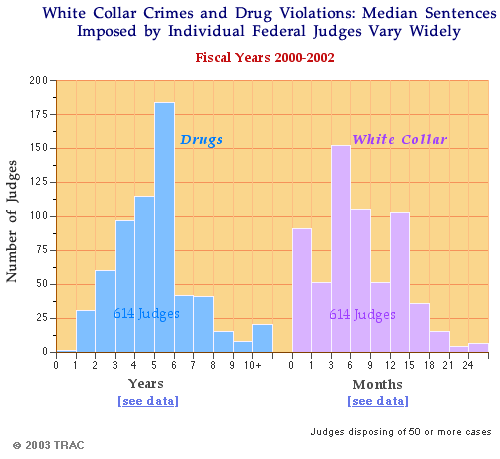
Federal Judges: Measuring Their Sentencing Patterns A TRAC Special Report
February 4, 2003A central goal of all courts is to treat similarly situated defendants in similar ways. In pursuing this goal at the federal level, the courts and Congress have created a complex system of law and regulation to guide the judges in what many consider their most serious responsibility.
In addition, the United States Sentencing Commission and other researchers have undertaken numerous studies which in the main have focused on determining whether defendants convicted of committing a given crime under a particular set of circumstances receive approximately the same punishment as other defendants found guilty of committing the same crime in approximately the same circumstance.This analysis by TRAC is different because it focuses on the "typical" or median sentences imposed by the judges rather than the sentences imposed on selected defendants.
The findings are based on the work of 614 federal District Court judges who in a very recent three-year period — fiscal year 2000 to fiscal year 2002 — were responsible for handling the cases of 151,395 defendants. These 614 judges were selected for two reasons. First, during the study period, each of them disposed of the cases of at least 50 defendants. Second, a sufficient number of these 50 or more cases were classified as involving white collar crime and drug violations. As a result of the relatively high productivity of this group of judges, they together were responsible for sentencing about 4 out of 5 of all drug and white collar crime defendants handled by the federal court system from 2000 to 2002.
The judge-by-judge analysis found considerable variation in the "typical" sentences imposed on the defendants whose prison terms were set by these judges. For example:
For drug cases, the median sentences — half got more and half got less — imposed by 189 judges were three years or less. At the opposite end of the scale, were 126 judges whose median sentences were six years or more.
For convicted white collar criminals, the median sentences for 142 of the judges were less than three months, including 91 whose median sentence was zero (no prison time). At the other end were 164 judges whose median sentences were 12 months or higher. There were six judges whose median white collar sentence was 24 months or more.

Because the kinds of drug or white collar crime cases in one district may be different than in another, the variation in the median sentences may be partly explained by this factor. Additional analysis by TRAC indeed found that some of the judge-to-judge variation in the typical sentence imposed may be related to district differences in the kinds of cases they were handling. But the analysis showed that about half of the variation in judge-to-judge median sentences for drug offenses occurred within each district — where the judges were likely to be presented with the same kinds of cases — rather than across districts. And for white collar crime, 85 percent of the judge-to-judge variation in median prison sentences was within individual districts. Thus, for example:
In a western district with 27 judges covered in the study, while the median sentence in that district for white collar defendants was 8 months prison time, the typical sentence of some judges was no prison time and for other judges as high as 18 months.
In a northeast district with 20 judges covered in the study, the median prison sentence for white collar offenders was 3 months prison time, with the typical sentence of some judges being no prison time and for others as high as 18 months.
Similarly, in a midwestern district with 11 judges covered in the study, the median sentence for drug defendants was 37 months, with the median sentence for some judges as low as 21 months while as high as 86 months for others.
In one relatively small southern district where 9 judges met the study's criteria the median drug sentence was 75 months. However, some judges in the district had a median prison sentence as low as 18 months and others as high as 99 months.
These initial findings, based on the development of an extensive new database by TRAC, offer new ways for examining America's continuing and complex effort to ensure equal justice for all.
More information is available with TRAC's new Judges tool, available by subscription to the TRACFED service. With this tool lawyers, Congress, reporters, scholars and public interest groups can now quickly examine many aspects of how federal district judges have functioned in the handling of the criminal and civil matters that have been disposed of in their courts. Covered are the activities of most judges on the bench from fiscal year 2002 to fiscal year 1986.
Matter-by-matter listings as well as statistics on a wide variety of indicators are available. In regard to criminal matters, for example, users can find out what percent of a particular judge's cases resulted in conviction, what percent those convicted in that judge's court were sent to prison and the median and average sentences that actually were imposed. Information on court processing times from filing to disposition are also available. In addition to providing this and other information about a selected judge, the special TRACFED tool also gives the user a way of comparing the records of one judge with that of others in the district or the nation as a whole. Similar kinds of judge-by-judge information are available for civil cases.
